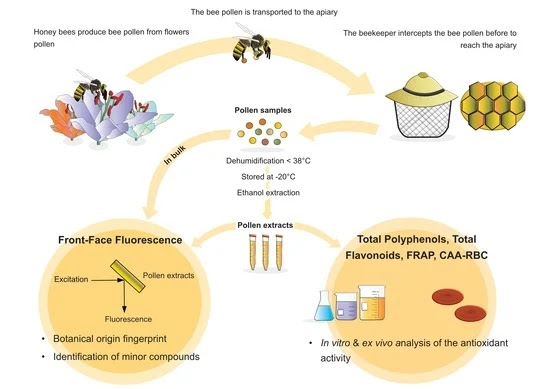Antioxidant, Nutraceutical Properties, and Fluorescence Spectral Profiles of Bee Pollen Samples from Different Botanical Origins
Antioxidants (Basel), 2020 Oct 15;9(10):E1001
Bee pollen is made by honey bees (Apis Mellifera) from the pollen of plants and flowers and represents an apiary product enriched in essential amino acids, polyphenols, omega-3, and omega-6 fatty acids.
This study investigated the botanical origin, micronutrient profile, and antioxidant activity of bee pollen samples (n = 10) harvested in Lucca and Massa Carrara (Tuscany, Italy) between 2016 and 2017. The palynological analysis showed that bee pollen samples were composed of nine botanical families. Front-face fluorescence spectroscopy was performed on bee pollen samples in bulk, without any treatment, and in ethanol extracts to determine the characteristic fluorescent profile and, to identify the main chemical compounds with biological activity.
The main chemical compounds detected were polyphenols (mainly flavonoids and phenolic acids), hydro-soluble vitamins (B2, B3, B6, and B9), amino acids, and pigments. Furthermore, the antioxidant activity was investigated, and one of the two Viburnum pollens resulted in the highest polyphenols and flavonoids content (20.15 ± 0.15 mg GAE/g fw and 23.46 ± 0.08 mg CE/g fw, respectively). However, Prunus and Eucalyptus families showed the highest in vitro (190.27 ± 8.30 µmol Fe2+/g) and ex vivo (54.61 ± 8.51 CAA unit) antioxidant capacity, respectively.
These results suggested that Tuscan bee pollen, depending on the botanical family, is rich in essential nutrients and potential nutraceutical product.

No comments:
Post a Comment